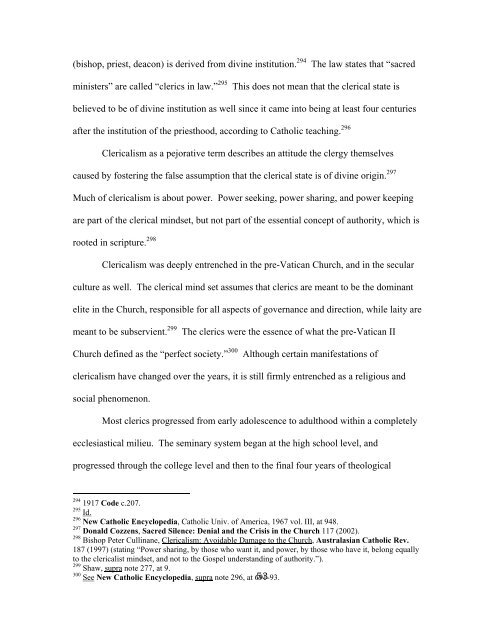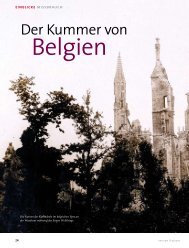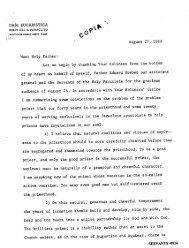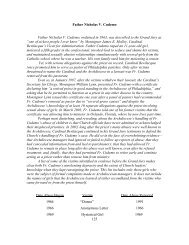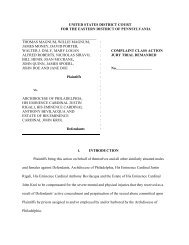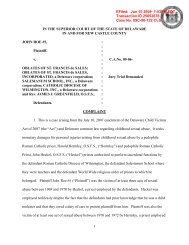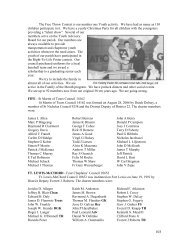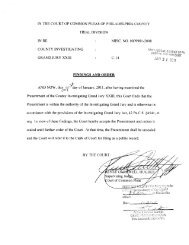1 1 Catholic Clergy Sexual Abuse Meets the Civil Law by Thomas P ...
1 1 Catholic Clergy Sexual Abuse Meets the Civil Law by Thomas P ...
1 1 Catholic Clergy Sexual Abuse Meets the Civil Law by Thomas P ...
Create successful ePaper yourself
Turn your PDF publications into a flip-book with our unique Google optimized e-Paper software.
(bishop, priest, deacon) is derived from divine institution. 294 The law states that “sacred<br />
ministers” are called “clerics in law.” 295 This does not mean that <strong>the</strong> clerical state is<br />
believed to be of divine institution as well since it came into being at least four centuries<br />
after <strong>the</strong> institution of <strong>the</strong> priesthood, according to <strong>Catholic</strong> teaching. 296<br />
Clericalism as a pejorative term describes an attitude <strong>the</strong> clergy <strong>the</strong>mselves<br />
caused <strong>by</strong> fostering <strong>the</strong> false assumption that <strong>the</strong> clerical state is of divine origin. 297<br />
Much of clericalism is about power. Power seeking, power sharing, and power keeping<br />
are part of <strong>the</strong> clerical mindset, but not part of <strong>the</strong> essential concept of authority, which is<br />
rooted in scripture. 298<br />
Clericalism was deeply entrenched in <strong>the</strong> pre-Vatican Church, and in <strong>the</strong> secular<br />
culture as well. The clerical mind set assumes that clerics are meant to be <strong>the</strong> dominant<br />
elite in <strong>the</strong> Church, responsible for all aspects of governance and direction, while laity are<br />
meant to be subservient. 299 The clerics were <strong>the</strong> essence of what <strong>the</strong> pre-Vatican II<br />
Church defined as <strong>the</strong> “perfect society.” 300 Although certain manifestations of<br />
clericalism have changed over <strong>the</strong> years, it is still firmly entrenched as a religious and<br />
social phenomenon.<br />
Most clerics progressed from early adolescence to adulthood within a completely<br />
ecclesiastical milieu. The seminary system began at <strong>the</strong> high school level, and<br />
progressed through <strong>the</strong> college level and <strong>the</strong>n to <strong>the</strong> final four years of <strong>the</strong>ological<br />
294<br />
1917 Code c.207.<br />
295<br />
Id.<br />
296<br />
New <strong>Catholic</strong> Encyclopedia, <strong>Catholic</strong> Univ. of America, 1967 vol. III, at 948.<br />
297<br />
Donald Cozzens, Sacred Silence: Denial and <strong>the</strong> Crisis in <strong>the</strong> Church 117 (2002).<br />
298<br />
Bishop Peter Cullinane, Clericalism: Avoidable Damage to <strong>the</strong> Church, Australasian <strong>Catholic</strong> Rev.<br />
187 (1997) (stating “Power sharing, <strong>by</strong> those who want it, and power, <strong>by</strong> those who have it, belong equally<br />
to <strong>the</strong> clericalist mindset, and not to <strong>the</strong> Gospel understanding of authority.”).<br />
299<br />
Shaw, supra note 277, at 9.<br />
300<br />
See New <strong>Catholic</strong> Encyclopedia, supra note 296, at 691-93.<br />
53


